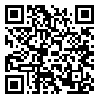Volume 10, Issue 1 (Autumn 2024)
Health in Emergencies and Disasters Quarterly 2024, 10(1): 67-76 |
Back to browse issues page
Ethics code: IR.IUMS.REC.1401.445
Download citation:
BibTeX | RIS | EndNote | Medlars | ProCite | Reference Manager | RefWorks
Send citation to:



BibTeX | RIS | EndNote | Medlars | ProCite | Reference Manager | RefWorks
Send citation to:
Ensafi Z, Kamali M, Bahadorizadeh L, Amiri Shavaki Y. The Lived Experiences of Speech-language Pathologists Regarding the Use of Telepractice During the COVID-19 Pandemic in Iran. Health in Emergencies and Disasters Quarterly 2024; 10 (1) :67-76
URL: http://hdq.uswr.ac.ir/article-1-571-en.html
URL: http://hdq.uswr.ac.ir/article-1-571-en.html
1- Department of Speech-Language Pathology, School of Rehabilitation Sciences, Iran University of Medical Sciences, Tehran, Iran.
2- Department of Rehabilitation Management, School of Rehabilitation Sciences, Iran University of Medical Sciences, Tehran, Iran.
3- Department of Internal Medicine, Rasoul-e-Akram Hospital, Iran University of Medical Sciences, Tehran, Iran.
4- Department of Speech-Language Pathology, School of Rehabilitation Sciences, Iran University of Medical Sciences, Tehran, Iran. ,amiriyoon@yahoo.com
2- Department of Rehabilitation Management, School of Rehabilitation Sciences, Iran University of Medical Sciences, Tehran, Iran.
3- Department of Internal Medicine, Rasoul-e-Akram Hospital, Iran University of Medical Sciences, Tehran, Iran.
4- Department of Speech-Language Pathology, School of Rehabilitation Sciences, Iran University of Medical Sciences, Tehran, Iran. ,
Abstract: (2363 Views)
Background: The COVID-19 pandemic caused many challenges to various clinicians, including speech-language pathologists (SLPs). Remote rehabilitation or telepractice was widely used during this period as a convenient solution by many therapists who had no experience in this field. This study aimed to survey the lived experience of telepractice by Iranian SLPs during the COVID-19 pandemic to identify the benefits and disadvantages of this method.
Materials and Methods: This qualitative study was conducted using content analysis. Twenty SLPs participated in this study. They were selected using a purposive sampling method until data saturation was reached. Semi-structured face-to-face interviews were used to collect information. Data were coded using MAXQDA software. After coding, the data were analyzed using the thematic analysis method, and the main themes were extracted. Finally, the trustworthiness of the data was measured based on Lincoln and Guba’s criteria.
Results: Five main themes were extracted, including “remote rehabilitation platforms”, “increasing efficiency”, “advantages”, “difficulties”, and “special opinions about telepractice”. Although telepractice had many difficulties, its advantages led to its widespread use during the pandemic.
Conclusion: SLPs in Iran used telepractice as a remote rehabilitation method during the pandemic. This method can be used in future pandemics, although it requires removing existing problems and creating the necessary infrastructure.
Materials and Methods: This qualitative study was conducted using content analysis. Twenty SLPs participated in this study. They were selected using a purposive sampling method until data saturation was reached. Semi-structured face-to-face interviews were used to collect information. Data were coded using MAXQDA software. After coding, the data were analyzed using the thematic analysis method, and the main themes were extracted. Finally, the trustworthiness of the data was measured based on Lincoln and Guba’s criteria.
Results: Five main themes were extracted, including “remote rehabilitation platforms”, “increasing efficiency”, “advantages”, “difficulties”, and “special opinions about telepractice”. Although telepractice had many difficulties, its advantages led to its widespread use during the pandemic.
Conclusion: SLPs in Iran used telepractice as a remote rehabilitation method during the pandemic. This method can be used in future pandemics, although it requires removing existing problems and creating the necessary infrastructure.
Type of article: Research |
Subject:
rehabilitation
Received: 2023/09/9 | Accepted: 2024/05/7 | Published: 2024/10/1
Received: 2023/09/9 | Accepted: 2024/05/7 | Published: 2024/10/1
Send email to the article author
| Rights and permissions | |
 |
This work is licensed under a Creative Commons Attribution-NonCommercial 4.0 International License. |








